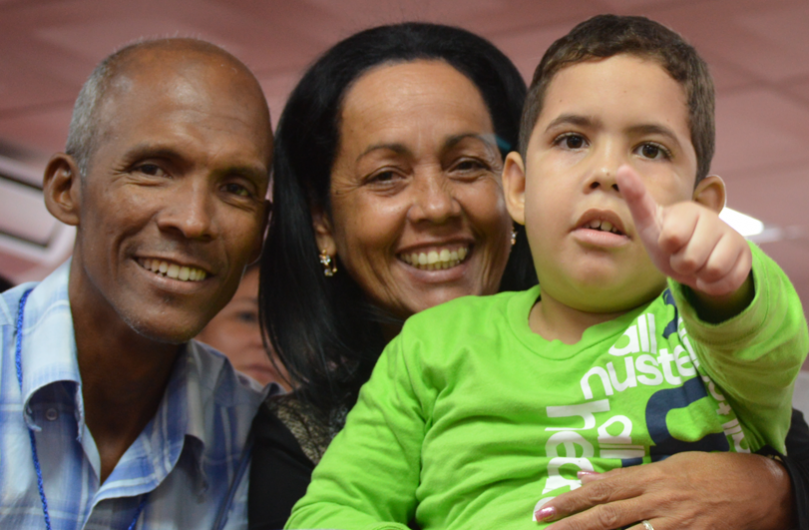Setting Boundaries
Personal boundaries are guidelines, rules or limits that a person creates to identify for themselves what are reasonable, safe and permissible ways for other people to behave around them and how they will respond when someone steps outside those limits. They are built out of a mix of beliefs, opinions, attitudes, past experiences and social learning (Wikipedia, the free encyclopedia).
People with PWS have a heightened anxiety and need others to set consistent and consistently enforced guidelines or boundaries for them to feel safe and respond appropriately to what is going on around them. Boundaries include positive behaviour strategies through the encouragement of desired behaviour rather than the punishment of undesired behaviour. Boundaries teach the person with PWS what is desired by you and society and how to communicate effectively. Anything taught must be simply stated, understandable and reinforced in a consistent manner to minimise anxiety.
Using boundaries is important for all people working with a person with PWS. They are tools to help reduce anxiety and poor reactions by the person with PWS to what is happening or being said to them. When boundaries are not put in place by all people involved with the person with PWS, it is confusing and problematic for the person with PWS. Lack of consistent use of boundaries can create long lasting difficulties for people with PWS. Boundaries keep us all “on the same page”.
Let’s remember how people with PWS think…
- For most people with PWS, there exists constant, life-long anxiety from choices to be made, the things they hear and see, the speed at which decisions have to be made, the constant drive to eat and in many cases, the desire to be “the same” as others. As well, most people with PWS are concrete thinkers! The words you use and the tone of voice you use are what the person with PWS will hear. Very few can “read between the lines” or interpret an underlying meaning. If you speak loudly or with even a slightly annoyed tone, they will “hear” that you are angry. This will increase their anxiety and most often result in a negative response! If you become anxious, their anxiety will also increase. Make every word count because the person with PWS will hear all the words but may not always understand the meaning of what is said. Using fewer words and a gentle voice keeps you calm and stops you saying words that can be misinterpreted or latched on to for an argument. Less is more
- Too much choice is confusing for people with PWS. Limited, appropriate choice keeps everyone safe. We would not ask someone with PWS: “where would you like to go, today?” We might ask: “would you like to see a movie or go to the zoo, today?” Less is more
- Using visual guides is always helpful! Too many instructions are confusing as people with PWS have a delay in their information processing ability and often miss bits of what is said. Displaying pictures to describe a task of several steps makes the process easier to understand. For example: washing hands – a picture is easier to understand, learn from and remember for people with PWS. Remember that people with PWS have enhanced spatial patterning skills – they take in the whole pattern at a glance!
The earlier in life boundaries are established, the easier it is for the person with PWS. By the time adulthood is reached, many parents are exhausted by the constant PWS management they have had to practise. Some parents also feel that as the person is now an adult, things will change or they should have the ability to be responsible for their own behaviour, and boundaries that were consistently in place when they were children, can now be relaxed. We know this is not the case for people with PWS. They will always require consistent behavioural management strategies, including firm, clear boundaries, which will be constantly tested by the person with PWS. If they think there is any chance of breaking them down they will persist even more so. Once boundaries have been loosened or the person with PWS has experienced the freedom of minimal or no boundaries, their world gradually starts to fall apart. It is then so much harder to reinstate the boundaries that had previously kept them feeling “safe” and had reduced behavioural outbursts. As well as respecting the individual with PWS we must remember to always respect the characteristics of the syndrome that will not change. Expectations for the person with PWS must remain realistic.
Reinstating boundaries is hard, but not impossible! Generally, a catalyst will help provide a platform from which to introduce change – that is, by changing the non “bounded” environment back to one that is “bounded”. Writing up new or reinstated boundaries in the form of a contract can be very helpful! Simple, clear explanations as to why the boundaries are necessary are essential and if possible, can be suggested by a doctor or other professional detached from the family.
Basic boundaries practised for children with PWS, for example, around the regularity and quantity of treat foods, will still apply to adults with PWS, however, the implementation of the boundaries may alter for the adult with PWS. Boundaries need to be reviewed frequently, to maintain their appropriateness to the individual and their effectiveness in each person’s situation. Boundaries may need to be adapted to different stages in life and changed circumstances – for example, during the transition period from school to post school programs or from a “community” program to a work program.
Be aware of changes in boundaries, especially those that sneak into the person’s usual lifestyle!
Parents are the initial and most important boundary setters, as they know their child (young or adult) better than anyone else and they have been the key people in the lives of their child. When an adult with PWS starts attending programs independent of family it is often seen as an opportunity to develop his/her independence. Parents may, often reluctantly, step back from their role as boundary-keeper, as they allow caregivers to develop a working relationship with their person with PWS. This is when boundaries may be refined for the situation, but their necessity still remains.
A parent writes…
When my daughter started attending a day program she was introduced to the practice of having an early morning coffee with the staff and again at tea time. This number of cups of coffee have gradually increased and become “holy ground” for her. In conjunction with this her use of artificial sweeteners has escalated dramatically, because she was in charge of the sweeteners. In hindsight, I realise I should have been more on the alert! The process to set new boundaries was a very difficult one and caused challenging behaviour. I should have kept limits on her usual daily coffee intake and never have allowed her to start using artificial sweeteners.
Should the breaking of boundaries carry consequences?
Consequences emphasise the importance of boundaries, but do people with PWS learn from consequences? We all know that food will be eaten if accessible, no matter what, and that having “punishment” type consequences around the eating of unplanned food is not fair for people with PWS. However, having appropriate consequences for known, discussed and understood boundaries, can be quite powerful. The consequences must also be well understood and always carried through, should a boundary be broken. Remember, the power of consistency!
For example: Peter loves bowling and usually goes every week. There is a cake shop on the way to bowling and on one occasion, when he was being taken to bowling by a casual staff member, he managed to get them to buy a fruit bun for him. His reason was that he had not eaten all of his breakfast and was feeling a little “weak”. The staff member was rebuked for allowing this, as it was not Peter’s schedule but he can be very convincing to unsuspecting new staff! Ever since this event, on occasions when Peter is in a bad mood, he will stop on his way to bowling and try to convince the staff member accompanying him, that he really needs a fruit bun. In most cases he is reminded of the “boundaries” but sometimes he will become very agitated and on rare occasions, a full blown temper tantrum will occur. His staff has now implemented the consequence of returning home immediately, should he becomes agitated concerning the cake shop. So he does not attend bowling that day. The frequency of missed bowling days is very low, as he is reminded of how much he enjoys bowling each night prior to his planned attendance.
Is it the boundary or the consequence that has improved Peter’s behaviour near the cake shop?
Possibly the answer is the combination of both. Both example situations highlight how important it is for all family members and caregivers to be well informed about PWS and the need for people with PWS to have consistent boundaries.
The most effective boundaries are those that are seen, by the person with PWS, to be beneficial to him/her in some way, or to be acceptable to an intelligent person, such as himself/herself.
What keeps a boundary effective is the belief in its worth and the consistent practice of that boundary.
This article was written by IPWSO’s Famcare Board.
International Community
IPWSO was established so that PWS associations, families, clinicians and caregivers around the world could exchange information and support and have a united global voice under one umbrella.
Information for Medical Professionals
The latest medical and scientific research and information, plus guides into common medical issues affecting people with PWS.



